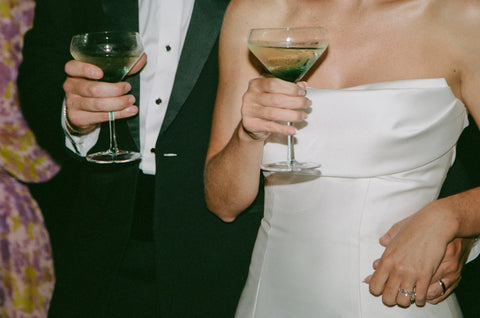For many men, the question of what to wear to a wedding can quickly overshadow the excitement of the celebration itself. The perfect wedding guest suit strikes a delicate balance—you want to look polished and appropriate without overshadowing the wedding party or appearing too casual for the occasion.
The venue plays a crucial role in determining your outfit choice. A beachfront ceremony calls for different attire than a grand ballroom affair, and that's before seasonal considerations enter the chat.
In this comprehensive guide, we'll decode wedding dress codes, provide venue-specific outfit recommendations, address seasonal considerations, and offer expert styling advice to help you select the ideal suit for wedding guest attire. From fabric selection to accessory pairings, we've covered everything you need to know to arrive well-dressed for any wedding celebration.
Table of Contents
Understanding Wedding Dress Codes
Before selecting your wedding guest attire men need to understand what the couple is actually asking for. Wedding invitations often include dress code specifications, but these can range from crystal clear to frustratingly vague. Here's a breakdown of common wedding dress codes and what they mean:
White Tie
The most formal dress code, rarely seen outside of extremely high-end events.
- Required: Black tailcoat with matching trousers, white wing-collar shirt, white vest, white bow tie, patent leather shoes
- Optional: White gloves, top hat
- Modern interpretation: Unless specified, a well-tailored black tuxedo can sometimes substitute
Black Tie
The classic formal dress code, typically for evening weddings in upscale venues.
- Required: Black tuxedo, formal white shirt, black bow tie, patent leather shoes
- Optional: Cummerbund or vest (matching the lapel fabric)
- Modern interpretation: Midnight blue has become an acceptable alternative to black
Black Tie Optional
Offers flexibility while maintaining formality.
- Best choice: Black tuxedo or formal dark suit
- Required: Dark suit (charcoal, navy, or black), tie, dress shoes
- Modern interpretation: This allows for some personality in accessories while keeping the overall look formal
Cocktail/Formal
Strikes a balance between black tie and business attire.
- Required: Dark suit, dress shirt, tie, polished dress shoes
- Optional: Pocket square, stylish cufflinks
- Modern interpretation: Allows for subtle patterns and texture in suits
Semi-Formal
Business attire with elevated styling.
- Required: Suit in any appropriate color, dress shirt, tie, dress shoes
- Optional: Seasonal colors and accessories
- Modern interpretation: Offers significant flexibility in color and pattern choices
Casual
The most flexible dress code, but still requires polish for wedding guest attire men.
- Required: Dress pants, button-up shirt, dress shoes or clean, dressy loafers
- Optional: Blazer or sport coat, tie
- Modern interpretation: Even "casual" weddings expect effort in your appearance
When no dress code is specified, default to semi-formal attire—one of our wedding suits in an appropriate color for the season and venue will do the trick. It's always better to be slightly overdressed than underdressed at a wedding. If you're truly uncertain, don't hesitate to ask the couple or wedding party about expectations, as wedding attire can vary widely based on cultural backgrounds and personal preferences.
Venue-Based Outfit Guide
The wedding venue offers crucial context for your outfit selection. Each setting comes with its own set of considerations for the perfect wedding guest suit. Here's how to dress appropriately based on different venue types:
Beach/Destination Wedding Attire
Beachfront ceremonies balance formality with practicality, requiring breathable fabrics that can withstand heat and humidity.
Formality Level: Typically semi-formal to casual, unless specified otherwise
Recommended Suit Options:
- Lightweight linen or cotton suit in light blue, tan, or stone
- Linen-cotton blends that resist wrinkling better than pure linen
- Tropical wool suits for more formal beach weddings

Styling Considerations:
- Skip the socks with loafers for casual beach ceremonies
- Consider slightly shorter hemlines to avoid dragging pants in sand
- Breathable dress shirts in cotton or linen blends
- Layer with a lightweight blazer that can be removed as needed
Seasonal Adaptations:
- Evening beach weddings may require an additional layer
- Destination weddings in tropical locations demand moisture-wicking fabrics
- Consider performance fabric blends with natural fibers for comfort
Expert Tip: For beach weddings, a well-fitted suit in a breathable fabric trumps formality. A linen suit in tan or light blue provides the perfect balance of polish and practicality for most beachfront ceremonies.
Garden/Outdoor Wedding Attire
Garden weddings offer an opportunity to incorporate seasonal colors while preparing for variable weather conditions.
Formality Level: Usually semi-formal to cocktail attire
Recommended Suit Options:
- Spring/Summer: Light to medium gray, blue, or tan suits
- Fall: Navy, olive, or burgundy suits
- Fabric weight should correspond to expected temperatures
- Cotton, lightweight wool, or seasonal blends

Styling Considerations:
- Floral or patterned accessories that complement the environment
- Earth tones harmonize with natural surroundings
- Textured fabrics like hopsack or subtle chambray add visual interest
- Sturdy dress shoes that can handle grass and outdoor surfaces
Seasonal Adaptations:
- Spring: Incorporate subtle pastels in accessories
- Summer: Lightest weight fabrics with maximum breathability
- Fall: Richer colors and slightly heavier fabrics
- Winter outdoor weddings: Consider wool overcoats and appropriate layers
Expert Tip: For daytime garden weddings, a light blue or medium gray suit offers versatility and photographs beautifully against natural backgrounds. Bring sunglasses and consider fabrics that won't show sweat easily.
Ballroom/Hotel Wedding Attire
Formal venues call for classic, refined suiting with attention to traditional details and accessories.
Formality Level: Cocktail to black tie, rarely casual
Recommended Suit Options:
- Charcoal gray or navy wool suit for cocktail/formal
- Black or midnight blue tuxedo for black tie
- Year-round weight wool
- Subtle patterning like herringbone or birdseye for added visual interest

Styling Considerations:
- French cuff shirts with elegant cufflinks
- Perfectly dimpled tie knots and precise pocket square folds
- Highly polished dress shoes (patent leather for black tie)
- Vest or waistcoat for three-piece formality
Day vs. Evening Considerations:
- Daytime: Lighter navy or gray suits with subtle patterning
- Evening: Darker suits with more formal accessories
- After 6 pm: Black tie or formal attire takes precedence
Expert Tip: For ballroom weddings, invest in proper tailoring—nothing undermines a formal look faster than a bad fit. Sleeve cuffs should show ¼-½ inch beyond your jacket sleeves, and trousers should have a slight break or no break over your shoes.
Rustic/Barn Wedding Attire
Rustic venues allow for incorporating texture and approachable formality while maintaining wedding-appropriate polish.
Formality Level: Usually semi-formal to casual
Recommended Suit Options:
- Textured fabrics like tweed, corduroy, or wool blends
- Earth tones, blues, or subtle plaids
- Three-piece suits with the option to remove the jacket
- Separates (contrasting blazer and trousers) for more casual events

Styling Considerations:
- Knit ties or textured bow ties
- Boots or brogues that handle rustic terrain
- Suspenders as a nostalgic touch (when appropriate)
- Tweed or textured blazers with complementary trousers
Seasonal Adaptations:
- Spring/Summer: Lighter fabrics with textural interest
- Fall/Winter: Heavier materials like flannel or tweed
- Consider venue heating/cooling when selecting fabric weight
Expert Tip: Rustic doesn't mean casual—elevate your look with thoughtful accessories and impeccable fit. A navy blazer with tan chinos and a patterned shirt offers versatility for most rustic venues.
Religious Venue Considerations
Religious ceremonies often have specific expectations regarding modesty and traditional attire.
Formality Level: Usually formal to semi-formal
Recommended Suit Options:
- Conservative suit colors: navy, charcoal, or black
- Full coverage regardless of temperature
- Traditional cut and styling without flashy details
- Modest accessories without ostentatious elements

Cultural/Religious Specifics:
- Some Orthodox ceremonies require head coverings
- Catholic ceremonies typically expect formal attire
- Mormon temples require specific modest attire
- Jewish ceremonies may include yarmulkes (provided for male guests)
Expert Tip: Research any religious customs before attending, particularly for unfamiliar traditions. When in doubt, opt for more conservative attire out of respect for the sacred space.
Seasonal Considerations
Beyond the venue, the season plays a crucial role in determining appropriate male wedding guest outfit:
Spring Wedding Guest Attire
Spring weddings offer the opportunity to incorporate fresh colors while preparing for variable temperatures.
Suit Selection:
- Medium-weight wools
- Light blue, gray, or tan suits
- Subtle seasonal patterns like windowpane or glen check
Fabric Considerations:
- Breathable wool that adapts to temperature fluctuations
- Cotton-wool blends for comfortable wear
- Preparations for unexpected weather (light rain jacket or umbrella)
Accessory Guidance:
- Floral or botanical pocket squares
- Pastel or dusty-colored ties
- Layer with waistcoats that can remain if jackets are removed
Summer Wedding Guest Attire
Summer demands the lightest, most breathable fabrics with attention to heat management.
Suit Selection:
- Lightweight wool, linen, cotton, or tropical weight wool
- Light colors: tan, stone, light blue, light gray
- Unconstructed jackets for maximum breathability
Fabric Considerations:
- Open-weave fabrics that allow airflow
- Moisture-wicking shirt materials
- Minimal lining to prevent overheating
Accessory Guidance:
- Linen pocket squares
- Knit or linen ties
- Consider loafers without socks for casual venues
- Explore alternatives to full suits for casual ceremonies
Fall Wedding Guest Attire
Fall weddings invite richer colors and textured fabrics as temperatures decline.
Suit Selection:
- Medium-weight wool
- Rich colors: navy, burgundy, olive, or brown
- Textured fabrics like flannel, tweed, or hopsack
Fabric Considerations:
- Seasonal wools with slight texture
- Layering pieces for variable temperatures
- Fabrics that maintain shape throughout a long event
Accessory Guidance:
- Wool or silk knit ties
- Richer, deeper pocket square colors
- Possibility of vests or waistcoats as functional layers
Winter Wedding Guest Attire
Winter demands thoughtful layering and fabric selection for both warmth and style.
Suit Selection:
- Heavier wool suits
- Flannel, tweed, or velvet
- Darker colors: charcoal, black, deep navy, or oxford blue

Fabric Considerations:
- Proper overcoats for outdoor transitions
- Insulating layers that don't bulk under suits
- Heavier twist yarns for better temperature regulation
Accessory Guidance:
- Wool/cashmere blend scarves for outdoor transitions
- Leather gloves in complementary colors
- Consider dress boots for snowy or wet conditions
Accessories Guide
The right accessories elevate your wedding guest suit from basic to impeccable, completing your men's outfit for wedding guest attire:
Neckwear
- Ties: Choose width based on lapel width (typically 2.5-3.5 inches)
- Bow Ties: Self-tie versions offer authenticity and personality
- Seasonal Considerations: Silk for most seasons, knit for fall/winter, linen or cotton for summer
- Pattern Guidance: Subtle patterns complement solid suits; solid ties balance patterned suits
Pocket Squares
- Should complement but not exactly match your tie
- White linen remains universally appropriate
- Fold complexity should match event formality
- Consider textural contrast to your suit fabric
Footwear
- Oxford shoes: Most formal option, appropriate for all wedding types
- Derby shoes: Slightly less formal, versatile for most venues
- Loafers: Only for casual to semi-formal weddings
- Boots: Consider for outdoor/rustic venues with appropriate styling
- Always well-polished regardless of style

Watches and Jewelry
- Understated timepieces with leather or metal bands
- Minimal jewelry beyond cufflinks and wedding band
- Match metals (silver/gold) consistently across accessories
- Sophisticated over flashy for formal events
Seasonally Appropriate Additions
- Spring/Summer: Lightweight pocket squares, potential for sunglasses
- Fall/Winter: Scarves, gloves, appropriate outerwear
- Consider practical accessories based on venue (umbrellas for garden weddings)
Expert Tips and Common Mistakes
Follow these professional guidelines to perfect your wedding guest suit:
Styling Do's
- Do: Have your suit properly tailored—regardless of rental or purchase
- Do: Choose fabrics appropriate for the season and venue
- Do: Ensure shoes are impeccably polished and in excellent condition
- Do: Press shirts and suits before wearing, even if recently cleaned
- Do: Consider the wedding party colors to complement without matching exactly
- Do: Test your complete outfit before the wedding day
Styling Don'ts
- Don't: Wear white, cream, or ivory suits (reserved for the wedding party)
- Don't: Choose a suit that's significantly more formal than the dress code
- Don't: Debut brand-new shoes without breaking them in first
- Don't: Over-accessorize or wear distracting statement pieces
- Don't: Neglect proper fit—too tight is as problematic as too loose
- Don't: Remove your jacket until appropriate (usually after dinner service begins)
Etiquette Considerations
- Respect cultural and religious traditions with appropriate attire
- Interpret "optional" dress codes as leaning toward formal rather than casual
- Consider the time of day—earlier events typically allow lighter colors and fabrics
- Remember that "casual" at a wedding is still elevated compared to everyday casual wear
- When traveling for weddings, pack suits properly to prevent wrinkles and damage
Frequently Asked Questions
Q: Can I wear black to a wedding?
A: Yes, particularly for evening or formal weddings. Black suits have become increasingly acceptable as wedding guest attire, especially for cocktail or black-tie optional events. For daytime or casual weddings, navy or charcoal often provides a more appropriate alternative.
Q: Is it appropriate to remove my jacket during the reception?
A: Generally, wait until the groom removes his jacket or until dinner service begins. Some traditional venues and cultures expect jackets to remain on throughout the event. When in doubt, observe other guests and follow the lead of the wedding party.
Q: How closely should I follow the dress code?
A: Treat the dress code as a requirement rather than a suggestion. If you're between formality levels, it's better to dress slightly more formally than risk appearing underdressed. Wedding photos last forever, and respecting the couple's wishes shows consideration.
Q: Can I wear the same suit to multiple weddings?
A: Absolutely. A well-chosen navy or charcoal suit serves as a versatile foundation for different wedding guest outfits. Simply vary your shirt, tie, pocket square, and other accessories to create distinct looks for different events.
Q: What if my outfit outshines the groom?
A: Focus on appropriateness rather than standing out. Avoid wearing anything identical to what you know the groom or groomsmen will wear. When in doubt, choose understated elegance over flash—the wedding day belongs to the couple, not the guests.
Q: How do I dress for a themed wedding?
A: Respect the theme while maintaining appropriate formality. For example, a "Gatsby" theme might call for vintage-inspired styling but still requires formal attire. Incorporate subtle themed elements rather than costume-like interpretations.
Conclusion
The perfect wedding guest suit balances respect for the occasion, venue appropriateness, seasonal considerations, and personal style. We know — it's a lot to process.
Your outfit should be memorable for its appropriateness and your confidence wearing it, not for standing out or breaking conventions. By considering the setting and selecting quality pieces that fit properly, you'll arrive appropriately dressed for any wedding celebration.
Whether you're building a versatile suit collection or seeking the perfect rental for a specific event, focusing on fit, fabric, and thoughtful styling ensures you'll be prepared for any wedding invitation that arrives in your mailbox.
Ready to find your perfect wedding guest suit? Explore our collection of wedding guest attire designed specifically for each venue type and season, with expert sizing and styling assistance to ensure you look your best on the big day (that isn't yours).









